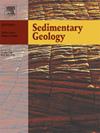Giant lacustrine bioherms in the northeastern Qinghai-Tibet Plateau (western Qaidam Basin) during the Early–Middle Miocene: Carbonate fabrics, growth patterns, and environmental significance
IF 2.9
2区 地球科学
Q1 GEOLOGY
引用次数: 0
Abstract
The development of lacustrine carbonate bioherms in the Qaidam Basin provides critical insights into the influence of the Qinghai-Tibetan Plateau (QTP) uplift and climate change on Asian interior lake ecosystems. Two distinct, successively developed phases of carbonate bioherm proliferation, each extending laterally for over 3 km, have been identified within the Lower to Middle Miocene siliciclastic-dominated strata of the western Qaidam Basin, northeastern Tibetan Plateau. These bioherms exhibit diverse morphologies—ranging from large domical structures (>3 m high) to smaller hemispherical and inverted conical forms (<1 m)—and are arranged either as biostromes within a single stratigraphic level or in complex, vertically stacked patterns. Green algae (Cladophorites and problematic Chlorellopsis) and putative calcimicrobes were the primary bioherm builders. The dominant alga Cladophorites primarily formed radially branching and dense-reticular frameworks. Putative calcified filamentous and spherical microbes, acting alone or in association with green algae, formed foundational cores or substrates. These were subsequently encased by stromatolitic crusts, which aggraded iteratively from lithified microbial mats via microbially induced mineralization. The frameworks contain abundant microsparitic (4–30 μm) calcite crusts and laminated fibrous calcite cements, complemented by fringing dolomite cement crusts at the margins; these features collectively enhanced the lithification and preservation of the bioherm structures. Through multi-scale petrographic and sedimentological analysis, ten distinct lithofacies were identified within the bioherms and adjacent strata. Based on the spatial and temporal distribution of these lithofacies, a three-stage evolutionary model is proposed for the bioherms, which includes: (1) an initiation stage on littoral quartz sand bars and ooid/peloid shoals; (2) a development stage during a gradual transgression; and (3) a termination stage marked by the deposition of littoral muds or distal sublittoral silts. The proliferation of large, algal-microbial bioherms in the plateau-type Qaidam Basin required a specific set of environmental conditions: warm, fresh-to-brackish waters, sufficient accommodation space, high alkalinity, and abundant nutrients. We propose a model highlighting the integrated effects of an enhanced hydrological cycle across the QTP, catalyzed by the Miocene Climatic Optimum. The spread of these carbonate bioherms into the typically cold, arid, and saline lacustrine environments of the QTP serves as a significant indicator of this extreme warming event, providing valuable insights into potential biological and sedimentological feedback mechanisms under analogous present-day warming conditions.
青藏高原东北部(柴达木盆地西部)早-中中新世巨型湖相生物礁:碳酸盐组构、生长模式及其环境意义
柴达木盆地湖相碳酸盐岩生物礁的发育为研究青藏高原隆升和气候变化对亚洲内陆湖泊生态系统的影响提供了重要依据。在青藏高原东北部柴达木盆地西部下中新世至中中新世以硅质塑料为主的地层中,发现了两个不同的、连续发育的碳酸盐岩生物礁扩散阶段,每个阶段横向延伸3 km以上。这些生物礁表现出不同的形态,从大的圆顶结构(3米高)到较小的半球形和倒锥形结构(1米高),它们要么作为生物礁排列在单一地层中,要么以复杂的垂直堆叠模式排列。绿藻(Cladophorites和有问题的小球藻)和推定的腐殖菌是主要的生物洞穴建造者。优势藻枝藻主要形成放射状分支和密集的网状框架。假定的钙化丝状和球形微生物,单独或与绿藻联合作用,形成基础核心或底物。它们随后被叠层石壳包裹,叠层石壳通过微生物诱导的成矿作用从岩化的微生物垫中迭代沉积而成。框架体中含有丰富的微颗粒(4-30 μm)方解石结壳和层状纤维方解石胶结物,边缘有边缘白云岩胶结物;这些特征共同促进了生物礁结构的岩化和保存。通过多尺度岩石学和沉积学分析,在生物礁及其邻近地层中识别出10种不同的岩相。根据这些岩相的时空分布,提出了三阶段生物礁的演化模式,即:(1)滨海石英砂坝和鲕状/球状浅滩的起始阶段;(2)渐进式海侵的发展阶段;(3)以滨海泥沙或远端滨海下泥沙沉积为标志的终止期。柴达木盆地高原型大型藻微生物生物礁的增殖需要一系列特定的环境条件:温暖、淡水到半咸淡水、充足的生存空间、高碱度和丰富的营养物质。我们提出了一个模型,强调了在中新世气候优化的催化下,整个青藏高原的水文循环增强的综合效应。这些碳酸盐生物礁在QTP典型的寒冷、干旱和盐碱化湖泊环境中的传播是这一极端变暖事件的重要指标,为在类似的当今变暖条件下潜在的生物和沉积反馈机制提供了有价值的见解。
本文章由计算机程序翻译,如有差异,请以英文原文为准。
求助全文
约1分钟内获得全文
求助全文
来源期刊

Sedimentary Geology
地学-地质学
CiteScore
5.10
自引率
7.10%
发文量
133
审稿时长
32 days
期刊介绍:
Sedimentary Geology is a journal that rapidly publishes high quality, original research and review papers that cover all aspects of sediments and sedimentary rocks at all spatial and temporal scales. Submitted papers must make a significant contribution to the field of study and must place the research in a broad context, so that it is of interest to the diverse, international readership of the journal. Papers that are largely descriptive in nature, of limited scope or local geographical significance, or based on limited data will not be considered for publication.
 求助内容:
求助内容: 应助结果提醒方式:
应助结果提醒方式:


